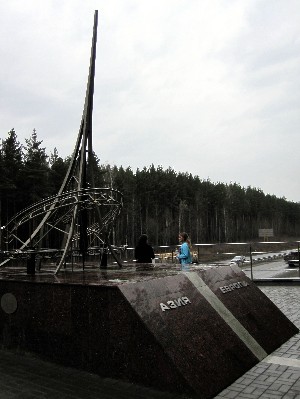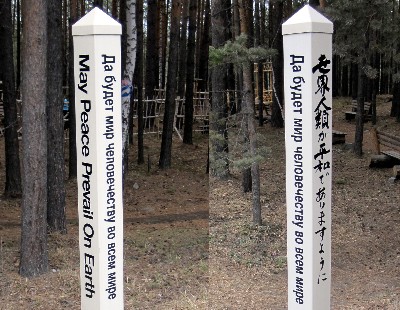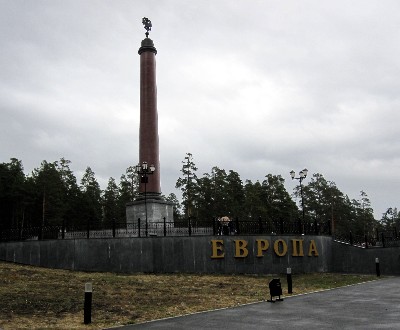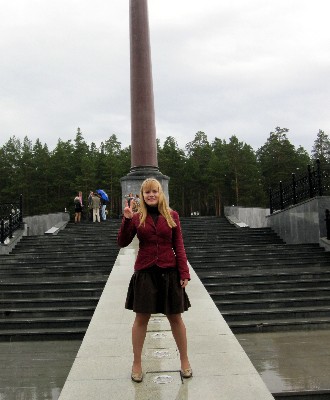On the Border: на границе Европы-Азии! Posted by josefina on Apr 25, 2010 in Culture, History, Russian life, Soviet Union, when in Russia
«Монумент на границе Европы–Азии» [the (new) monument on the border between Europe and Asia] «на московском тракте» [on the highway to Moscow (from Siberia)].
Have you ever dreamed of being in two places at one and the same time? «На Урале» [in the Ural Mountains] all your dreams can come true – including this one! Russia is great country in many, many ways; one way in which it is great is that it spans more than one continent: «Россия расположена и в Европе, и в Азии» [Russia is located both in Europe and in Asia]. Everybody’s favorite country has its historical core as well as most of its population (72%), economic activity and political institutions (such as its capital city «Москва» [Moscow]) in Europe, yet geographically most of the territory (71%) is actually in Asia. Most people are aware of the fact that «граница между Европой и Азией» [the border between Europe and Asia] goes somewhere in the Ural Mountains. Very few know exactly where this «граница находится» [border is located]. Maybe no one actually knows. It is ‘generally accepted’ that the border follows along the river «Урал» [Ural] but not everywhere in the Urals is this general acceptance respected. Like for example in «Екатеринбург» [Yekaterinburg], where I live. Our local historians have – according to what I have been told by them – decided that the border between Europe and Asia is located not far from Yekaterinburg, some 50 kilometers to the west, near the town of «Первоуральск» [Pervoural’sk]. This is of course a very convenient decision. Already in Soviet times a big and flashy «монумент» [monument] was built on the site in honor of its prestigious location on the border, so that tourists could go visit it and take pictures of themselves with their legs «в разных частях мира» [in different parts of the world]. But with time it turned out that this monument had been built not in the ‘right’ spot. Not that it wasn’t ‘officially’ on the border, but that it was located by «старомосковский тракт» [the old highway to Moscow]. When the new highway to Moscow was finished this monument found itself more than a little bit off – adding to this that the old highway was in such a terrible shape that not even the most humble Russian would want to risk taking foreign tourists on it. The old highway is still in a terrible shape; yesterday when we drove back on it my professor repeated the good old Russian proverb «у России две беды – дураки и дороги» [Russia has two sorrows – fools and roads] twice. But this problem was easily solved: a new monument was built on the new highway. The new monument is not only «скромнее» [more humble] than the old one but also more ‘American’ – it is complete with a gift shop and a snack bar and has plenty of places where one can pose for pictures as well as many of benches for «туристы» [pl. tourists] to have a rest on in the nearby wood. If the old monument was all about RUSSIA being on the border – it is «гордо» [proudly] topped by the two-headed eagle – then the new one is more about FRIENDSHIP between countries over the same border. Take a look at the picture below from the site of the new monument:
The same beautiful and hopeful message written in three languages on one and the same pole: «на азиатской стороне» [on the Asian side] «написано по–китайски» [it is written in Chinese], «на европейской стороне» [on the European side] «написано по–английски» [it is written in English] and «в середине» [in the middle] «написано по–русски» [it is written in Russian].
Even though the border between Europe and Asia is only a short car ride away from Yekaterinburg – where I have lived «с августа 2006 (две тысячи шестого) года» [since August 2006] – I had not visited it until yesterday. Why? I don’t know. Maybe it is because it is the one thing that all tourists visiting this city MUST do, but I’ve never felt like I’ve been a «туристка» [fem. tourist] here. Also I don’t have a car – «у меня даже водительских прав нет!» [I don’t even have a driver’s license!] – and this could have played a large role as to why I never went there for so many years. But I can highly recommend visiting it, even though it is just a place marked by some local historians and the ‘real’ border between Europe and Asia could just as well be somewhere entirely else. If you want to be really sure that you have had one foot both in Europe as well as in Asia at one and the same time, then you should visit «Оренбург» [Orenburg] in the Southern Urals which is a true «пограничный город» [boundary; frontier town]: it belongs to both Europe and Asia at one and the same time. It is also the town where Pushkin’s prose masterpiece «Капитанская дочка» [“The Captain’s Daughter”] is set – and now you have two solid reasons for why to go there! But no, I haven’t been there either…
A snapshot of the ‘old’ monument taken from a European perspective.
The locals here usually don’t say the whole phrase «граница Европы–Азии» [the border of Europe and Asia] but shorten it simply as «Европа–Азия» [Europe-Asia]. I guess that makes a lot of sense because that’s just what it is. Russians here sometimes say things like:
«Поехали на Европу–Азию!» [Let’s go to (the border between) Europe and Asia!]
«Мы были на Европе–Азии» [We were at (the border between) Europe and Asia].
Here I am –with one foot «в Европе» [in Europe] and the other «в Азии» [in Asia]. But all of me is still «в России» [in Russia]… Sometimes when I think of the fact that I’ve lived in ASIA since February 2005 I get puzzled: is Russia really Asia? Yes and no. That it is IN Asia, well, that’s a given – isn’t it?
Have you ever visited the border between Europe and Asia? If yes – where? If no – then maybe you’ve been on two places at one and the same time somewhere else?

Build vocabulary, practice pronunciation, and more with Transparent Language Online. Available anytime, anywhere, on any device.








Comments:
Charly:
Great post – and it looks like a fun trip. 🙂
I’ve never been to the border between Europe and Asia, but it reminded me of our trip to the Equator when we were in Ecuador.
Very funny, too. And a weird experience – as it included the the demonstration of changes of physical laws…
Vanessa:
I have crossed the border between Europe and Asia on the river Ural close to Magnitogorsk. I remember the sign on the bridge as I was crossing the river, but I didn’t think too much of it at the time. Many people don’t realize how Aisian Russia is.
yue:
on the second picture of the post, it is not chinese, but japanese